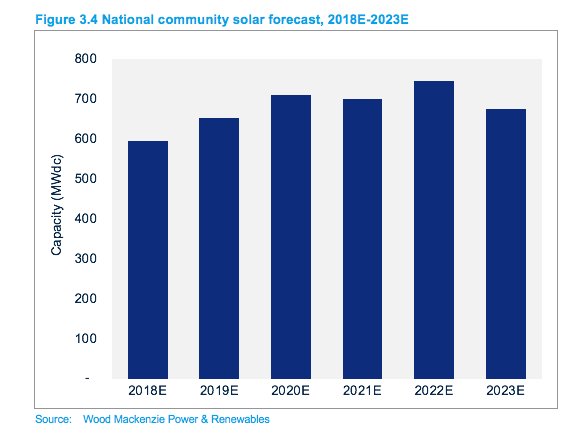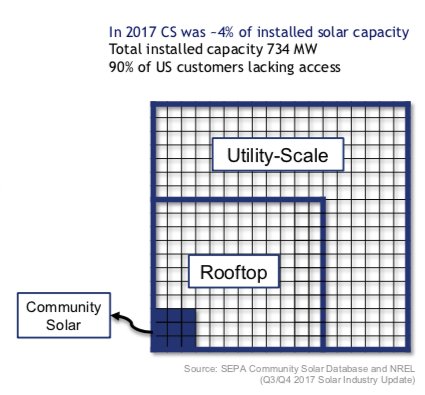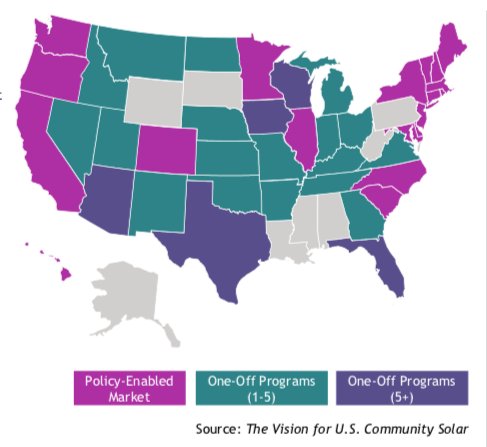By many measures, community solar is on the rise.
In the last year, it’s driven an outsized portion of overall solar growth. Though analysts are still finalizing the numbers, Wood Mackenzie Power & Renewables forecasted community solar would be the driver of over one-third of annual solar demand in 2018. By 2023, analysts expect community solar to make up 30 percent of non-residential solar deployments.
Minnesota has so far dominated the sector, serving as the site for over half of all 2018 community solar installations. But WoodMac also forecasts that by the end of 2020, the state will account for less than 5 percent of the market. Other states, where markets are emerging, will fill in. Just this week, Democratic Florida State Senator Lori Berman introduced community solar legislation, and bills to create community solar programs advanced in New Mexico and South Carolina.

It’s within that context that consulting firm DEFG released its recent report on making community solar more accessible to low-income customers. The working group for the report — comprising 60 participants including utilities such as Michigan’s Consumers Energy, community solar accessibility organization Solstice, and utility and corporation commissions from seven states and Washington, D.C. — received grants from sources including the Department of Energy, Illinois’ Commonwealth Edison and the embattled Pacific Gas & Electric to compile the findings.
“There’s a lot of interest in wanting to bring together solar access for low-income communities,” said Judith Schwartz, the lead author of the repot and president of consulting group To The Point. “This goal of equitable access to renewables is a good goal that’s on the top of everybody’s mind, but how do you do it?”
Wood Mackenzie and Vote Solar released a report last year on that very topic. The DEFG report adds to the body of knowledge on making solar more inclusive.
Building for accessibility
The group came up with a variety of recommendations that planners can mix and match “cookbook style,” according to Schwartz, to create programs. Broadly, they recommend that regulators, utilities, consumer advocates, investors and state and local governments work to make community solar programs as flexible and varied as possible, so they’re able to include a greater number of users.
“What we saw is, if your goal is to make solar more available to this community, one size is not going to fit all,” said Schwartz.
According to 2017 data, 90 percent of U.S. customers lack access to community solar. That year, community solar made up just about 4 percent of installed solar capacity nationwide, according to data from the Smart Electric Power Alliance and the National Renewable Energy Laboratory. WoodMac data puts the number even lower in early 2018, at less than 2 percent of overall installed capacity.

While 2018 has been a growth year for the segment, it’s still dwarfed by more mature sectors like distributed and utility-scale solar. As noted, more and more states are working on community solar programs, but many states have focused on one-off programs rather than policy-enabled markets.

Even fewer states have incorporated specific initiatives in those programs to support low-income users.
That’s significant, because one of the most enticing attributes of community solar, according to its advocates, is its ability to open solar to residential customers who are unable to access traditional rooftop installations.

Outside of state policies, and as noted in previous coverage of community solar in this Squared column, the solar industry’s reliance on long contracts and creditworthiness have thrown up barriers to renters signing up to community solar projects. Organizations like Solstice are hoping to make the segment more flexible.
DEFG’s report offers possible ways to get there.
The working group notes that, if making community solar available to low-income residents is a priority, as many program managers have claimed, planners may need to incorporate some type of “sweetener” to help projects pencil out economically. That could come in the form of participation subsidies offered to low-income subscribers, incremental incentives, or tax credits for project developers.
Enticing solar developers
Drawing in developers to work on community solar deals, especially those that serve low-income subscribers, can be difficult, because some view a subscription model with potential turnover as being higher risk than projects with a large, creditworthy offtaker.
But even in the last few months, Andrew Alayza, Solstice’s marketing director, has noticed that demand for community solar has pushed developers to become more flexible about credit scores and contract terms and length. Solstice is specifically working to fix the credit issue with its EnergyScore, a qualification metric the company says is 40 percent more accurate than a FICO score in predicting whether subscribers will pay their bills.
“The FICO score doesn’t really take into account someone’s propensity to use their energy bill,” said Alayza, adding, “Not being as picky with who you enroll, it becomes cheaper to acquire these customers and you’re able to offer bigger savings.”
As more developers get comfortable, that perception of risk should continue to shift. MJ Shiao, formerly of WoodMac and now director of community solar at Arcadia Power, previously told GTM that having a roster of subscribers may actually be less risky than relying on a large offtaker. But for now, many currently functioning projects use an anchor offtaker to mitigate perceived risk for developers.
The working group behind the report suggested that incentives or subsidies may help further entice developers. Cities and utilities can also push more projects to completion by acting as anchor offtakers. According to the latest WoodMac numbers, through Q3 2018, third parties led 65 percent of community solar deployed in 2018, while utilities accounted for only 35 percent of deployments.
The group also concluded that there should be as few regulatory restrictions as possible on who can develop, build and offtake these projects, as long as they help service low-income customers. “Increasing low-income access to shared solar will [require the efforts of] all stakeholders with a potential interest,” the group wrote.
Schwartz said those involved in creating the programs should also evaluate community solar projects using more than pure economic benefits. Aside from reducing individual bills, the report notes that community solar installations can provide value as a resiliency solution or through avoided cost for other resources.
“The value of community solar is not so much that one person, or one family, or one business benefits off the output of the solar panel,” she said, “but that there is a collective benefit.”
More models
Included in its recommendations, the working group outlined a variety of community solar program models that could open projects to more participants.
A typical subscription model is currently the most common. Though Schwartz noted that subscription community solar programs have “tremendous variability,” they generally include a single project with an associated roster of subscribers. As long as participants stay current on their subscription, they receive a credit directly on their electricity bill or on a separate bill through the program.
Alayza at Solstice said the company expects subscription models to continue flourishing because they’re relatively simple to understand and are viewed as low-risk. But he added that, in the community solar space, “a variety of models is helpful in the sense that you have different situations and you have different needs” in various communities.
The DEFG report laid out four models that may expand accessibility.
One, as mentioned, would value a community solar project for the resiliency it provides to the community. Because an installation could continue serving power to a critical site like a community center in extreme weather events or other crises, the provider could monetize the installation and distribute benefits to participants. In these cases, upfront financing might come from a local government looking for specific resilience projects. The installation would also include other clean energy assets like storage to allow it to act as an islanded microgrid.
The authors also presented a utility-led option where benefits would go toward existing debt owed by some ratepayers. Under that model, the utility provides funding with help from state incentives or rebates and either builds the project outright or works with another developer.
A nonprofit partnership model pairs a utility and a community solar developer specifically focused on low-income accessibility projects. Incentives or grants would lower the cost of the power-purchase agreement to make project participation open to more consumers. The report’s authors also recommend establishing a pool of reserve funds to guard against potential missed payments, so subscribers don’t lose the associated credit benefits.
Another model, called "community solar for community action," relies on a group of community-based organizations, private donors and impact investors to fund the project, which would employ local residents and offer training programs. A local utility could act as the offtaker and would distribute benefits through energy assistance programs.
That last model is already in practice in Minnesota, owned and operated by the Leech Lake Band of Ojibwe, and in Vermont. Schwartz said many of the models are based on real-world applications.
“The other models were all relevant to projects that are actually happening,” she said.
The group hopes its document will provide a framework that makes it easier for future community solar projects to actively incorporate accessibility for low-income participants. But Schwartz cautioned that ultimately the community needs to have a significant voice in any program.
“One of the common truths for all the projects is you have to have community support for what you’re doing,” said Schwartz. “In order for these things to work, you need community input, involvement and ownership.”